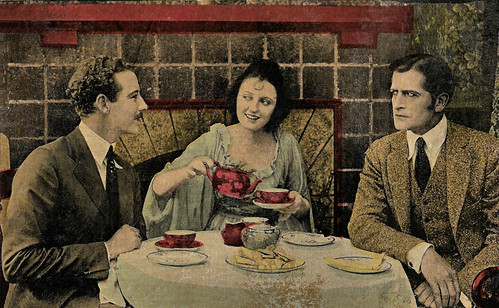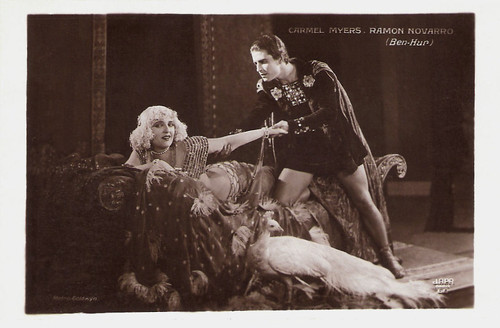Carmel Myers and Thomas Holding were the stars in the American romantic comedy The Dream Lady (Elsie Jane Wilson, 1918). The Bluebird Photoplays (Universal) production was based on the novel 'Why Not?' by Margaret Widdener. The Spanish chocolate factory Chocolat Imperiale in Barcelona released a series of 6 Cromos of the film which were printed by Exclusivas Verdaguer SA, Barcelona. The Spanish title of the film is ¿Por qué no..?.

Spanish cromo for Chocolat Imperiale, Barcelona, by Exclusivas Verdaguer SA, Barcelona, no. 1 of 6 cards. Photo: Transatlantic Film. Carmel Myers and Thomas Holding in The Dream Lady (Elsie Jane Wilson, 1918).

Spanish cromo for Chocolat Imperiale, Barcelona, by Exclusivas Verdaguer SA, Barcelona, no. 2 of 6 cards. Photo: Transatlantic Film. Carmel Myers and Thomas Holding in The Dream Lady (Elsie Jane Wilson, 1918).
In The Dream Lady (Elsie Jane Wilson, 1918), Carmel Myers plays the orphan Rosamond, who grows up on her own, without friends, but who has a vivid imagination.
Using a small but substantial inheritance after her uncle dies, heroine Rosamond Gilbert sets up a fortune-telling business. No mere charlatan, Rosamond is a "true believer" and she hopes to use her crystal ball to make her customers' dreams come true.
Her first client is Sydney Brown (Kathleen Mereson), a young woman who, unhappy in love, expresses the desire to become a man. Rosamond dresses the girl in male garb and arranges for her to go into business with her former boyfriend James Mattison (Harry von Meter), who one day confesses he would love to marry a girl with Sydney's qualities...
Rosamond also advises her neighbour, John Squire (Thomas Holding), to invest with a certain Jerrold (Philo McCullough), who proves to be a cheat. John finds out just in time. He forgives Rosamund, and in love with her, even asks her to marry him. As 'marrying a gentleman' was on Rosamund's to-do list, she eagerly accepts.
Considered first a lost film, a print was found and preserved by Les Archives di Film (CNC, Bois d'Arcy, France). Dawn Glory at the blog Is it interesting: "This was a very enjoyable little film, and Elsie Jane Wilson did a commendable job directing it." And Hal Erickson at AllMovie: "This delightfully daffy confection was designed primarily to capitalize on the charms of Carmel Myers, and in this respect, it was a success."

Spanish cromo for Chocolat Imperiale, Barcelona, by Exclusivas Verdaguer SA, Barcelona, no. 4 of 6 cards. Photo: Transatlantic Film. Carmel Myers and Thomas Holding in The Dream Lady (Elsie Jane Wilson, 1918).

Spanish cromo for Chocolat Imperiale, Barcelona, by Exclusivas Verdaguer SA, Barcelona, no. 5 of 6 cards. Photo: Transatlantic Film. Carmel Myers in The Dream Lady (Elsie Jane Wilson, 1918).

Spanish cromo for Chocolat Imperiale, Barcelona, by Exclusivas Verdaguer SA, Barcelona, no. 6 of 6 cards. Photo: Transatlantic Film. Kathleen Mereson and Carmel Myers in The Dream Lady (Elsie Jane Wilson, 1918).
Sources: Hal Erickson (AllMovies), Dawn Glory (Is it interesting), Wikipedia (Italian and English), and IMDb.

Spanish cromo for Chocolat Imperiale, Barcelona, by Exclusivas Verdaguer SA, Barcelona, no. 1 of 6 cards. Photo: Transatlantic Film. Carmel Myers and Thomas Holding in The Dream Lady (Elsie Jane Wilson, 1918).

Spanish cromo for Chocolat Imperiale, Barcelona, by Exclusivas Verdaguer SA, Barcelona, no. 2 of 6 cards. Photo: Transatlantic Film. Carmel Myers and Thomas Holding in The Dream Lady (Elsie Jane Wilson, 1918).
A delightfully daffy confection
In The Dream Lady (Elsie Jane Wilson, 1918), Carmel Myers plays the orphan Rosamond, who grows up on her own, without friends, but who has a vivid imagination.
Using a small but substantial inheritance after her uncle dies, heroine Rosamond Gilbert sets up a fortune-telling business. No mere charlatan, Rosamond is a "true believer" and she hopes to use her crystal ball to make her customers' dreams come true.
Her first client is Sydney Brown (Kathleen Mereson), a young woman who, unhappy in love, expresses the desire to become a man. Rosamond dresses the girl in male garb and arranges for her to go into business with her former boyfriend James Mattison (Harry von Meter), who one day confesses he would love to marry a girl with Sydney's qualities...
Rosamond also advises her neighbour, John Squire (Thomas Holding), to invest with a certain Jerrold (Philo McCullough), who proves to be a cheat. John finds out just in time. He forgives Rosamund, and in love with her, even asks her to marry him. As 'marrying a gentleman' was on Rosamund's to-do list, she eagerly accepts.
Considered first a lost film, a print was found and preserved by Les Archives di Film (CNC, Bois d'Arcy, France). Dawn Glory at the blog Is it interesting: "This was a very enjoyable little film, and Elsie Jane Wilson did a commendable job directing it." And Hal Erickson at AllMovie: "This delightfully daffy confection was designed primarily to capitalize on the charms of Carmel Myers, and in this respect, it was a success."

Spanish cromo for Chocolat Imperiale, Barcelona, by Exclusivas Verdaguer SA, Barcelona, no. 4 of 6 cards. Photo: Transatlantic Film. Carmel Myers and Thomas Holding in The Dream Lady (Elsie Jane Wilson, 1918).

Spanish cromo for Chocolat Imperiale, Barcelona, by Exclusivas Verdaguer SA, Barcelona, no. 5 of 6 cards. Photo: Transatlantic Film. Carmel Myers in The Dream Lady (Elsie Jane Wilson, 1918).

Spanish cromo for Chocolat Imperiale, Barcelona, by Exclusivas Verdaguer SA, Barcelona, no. 6 of 6 cards. Photo: Transatlantic Film. Kathleen Mereson and Carmel Myers in The Dream Lady (Elsie Jane Wilson, 1918).
Sources: Hal Erickson (AllMovies), Dawn Glory (Is it interesting), Wikipedia (Italian and English), and IMDb.










